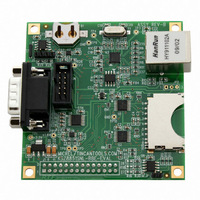KSZ8851SNL-BBE-EVAL Micrel Inc, KSZ8851SNL-BBE-EVAL Datasheet - Page 14

KSZ8851SNL-BBE-EVAL
Manufacturer Part Number
KSZ8851SNL-BBE-EVAL
Description
BOARD EVAL MAC/PHY FOR KSZ8851
Manufacturer
Micrel Inc
Series
LinkMD®r
Datasheets
1.KSZ8851SNL-BBE-EVAL.pdf
(80 pages)
2.KSZ8851SNL-BBE-EVAL.pdf
(3 pages)
3.KSZ8851SNL-BBE-EVAL.pdf
(1 pages)
Specifications of KSZ8851SNL-BBE-EVAL
Design Resources
BeagleBoard Zippy2
Main Purpose
Interface, Ethernet Controller (PHY and MAC)
Embedded
No
Utilized Ic / Part
KSZ8851SNL
Primary Attributes
1 Port, 100BASE-TX/10BASE-T
Secondary Attributes
SPI Interface, LinkMD Cable Diagnostics
Lead Free Status / RoHS Status
Lead free / RoHS Compliant
Other names
576-3602
KSZ8851SNL-BBE-EVL
ZIPPY2
KSZ8851SNL-BBE-EVL
ZIPPY2
Available stocks
Company
Part Number
Manufacturer
Quantity
Price
Company:
Part Number:
KSZ8851SNL-BBE-EVAL
Manufacturer:
Micrel Inc
Quantity:
135
Micrel, Inc.
KSZ8851SNL/SNLI
The KSZ8851SNL will also assert PME output pin if the corresponding enable bit[8] is set in PMECR (0xD4) register or
generate interrupt to signal an energy detect event occurred if the corresponding enable bit[2] is set in IER (0x90) register.
Once the power management unit detects the PME output asserted or interrupt active, it will power up the host CPU and
issue a wakeup command which is any one of registers read or write access to wake up the KSZ8851SNL from the low
power state to the normal power state in case the auto-wakeup enable bit[7] is disabled. When KSZ8851SNL is at normal
power state, it is able to transmit or receive packet from the cable.
Soft Power Down Mode
The soft power down mode is entered by setting bit[1:0]=10 in PMECR register. When KSZ8851SNL is in this mode, all
PLL clocks are disabled, the PHY and the MAC are off, all internal registers value will not change, and the host interface
is only used to wake-up this device from current soft power down mode to normal operation mode.
In order to go back the normal operation mode from this soft power down mode, the only way to leave this mode is
through a host wake-up command which the CPU issues any one of registers read or write access.
Power Saving Mode
The power saving mode is entered when auto-negotiation mode is enabled, cable is disconnected, and by setting
bit[1:0]=11 in PMECR register and bit [10]=1 in P1SCLMD register. When KSZ8851SNL is in this mode, all PLL clocks are
enabled, MAC is on, all internal registers value will not change, and host interface is ready for CPU read or write. In this
mode, it mainly controls the PHY transceiver on or off based on line status to achieve power saving. The PHY remains
transmitting and only turns off the unused receiver block. Once activity resumes due to plugging a cable or attempting by
the far end to establish link, the KSZ8851SNL can automatically enabled the PHY power up to normal power state from
power saving mode.
During this power saving mode, the host CPU can program the bit[1:0] in PMECR register and set bit[10]=0 in P1SCLMD
register to transit the current power saving mode to any one of the other three power management operation modes.
Wake-on-LAN
Wake-up frame events are used to wake the system whenever meaningful data is presented to the system over the
network. Examples of meaningful data include the reception of a Magic Packet, a management request from a remote
administrator, or simply network traffic directly targeted to the local system. In all of these instances, the network device is
pre-programmed by the policy owner or other software with information on how to identify wake frames from other network
traffic. The KSZ8851SNL controller can be programmed to notify the host of the wake-up frame detection with the
assertion of the interrupt signal (INTRN) or assertion of the power management event signal (PME).
A wake-up event is a request for hardware and/or software external to the network device to put the system into a
powered state (working).
A wake-up signal is caused by:
1. Detection of energy signal over a pre-configured value (bit 2 in ISR register)
2. Detection of a linkup in the network link state (bit 3 in ISR register)
3. Receipt of a Magic Packet (bit 4 in ISR register)
4. Receipt of a network wake-up frame (bit 5 in ISR register)
There are also other types of wake-up events that are not listed here as manufacturers may choose to implement these in
their own way.
Detection of Energy
The energy is detected from the cable and is continuously presented for a time longer than pre-configured value,
especially when this energy change may impact the level at which the system should re-enter to the normal power state.
Detection of Linkup
Link status wake events are useful to indicate a linkup in the network’s connectivity status.
August 2009
14
M9999-083109-2.0















